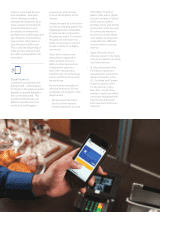Visa 2014 Annual Report Download - page 20
Download and view the complete annual report
Please find page 20 of the 2014 Visa annual report below. You can navigate through the pages in the report by either clicking on the pages listed below, or by using the keyword search tool below to find specific information within the annual report.
b. EMV-chip payment technology: Visa is addressing fraud at the physical point-of-
sale by working with merchants and issuers in the United States to introduce EMV-
chip payment technology.
c. Fraud and data analytics: As an industry leader in payment security, we enhanced
our real-time data analytics capabilities. When combined with Visa’s centralized
network structure, these capabilities allow financial institution clients and
merchants to identify and address fraud.
iii. New platforms, products and services. Visa continues to develop new platforms, products
and services to benefit financial institution clients, merchants and consumers.
a. Visa Checkout: Visa Checkout is a fast, simple and intuitive payment experience
that allows consumers to pay for goods online, on any device, in just a few clicks.
This service is presently available to eCommerce merchants and financial
institutions in the United States, Canada and Australia.
b. Visa payWave: With Visa payWave technology, consumers are able to pay for
products and services via smart phone and by using their contactless cards at
physical retailers. Visa Direct:
c. Visa Direct: Visa Direct simplifies the way people send and receive money both
domestically and across borders. In 2014, this service had a rapid growth in use,
particularly in emerging markets where there is a high demand for person-to-
person payments. Visa Direct is offered through financial institutions, and takes
advantage of Visa’s global network of 14,000 financial institutions and 2.2 billion
accounts to facilitate fast and secure money transfers.
•Regulation. Rules were implemented in the United States during 2011 and 2012 with respect
to debit products under the Dodd-Frank Wall Street Reform and Consumer Protection Act (the
“Dodd-Frank Act”), which regulates, among other things, debit interchange reimbursements
rates, the availability of debit networks, financial institutions’ and merchants’ choices among
these networks, and transaction routing. As a result, we have significantly modified our debit
strategy and continue to renegotiate some portions of our contracts with our financial institution
clients. On March 21, 2014, the Court of Appeals for the D.C. Circuit reversed a district court
ruling invalidating these rules. The appeals court agreed with the Federal Reserve, except for a
single issue related to the interchange cost calculation which was referred back to the Federal
Reserve for reconsideration. On August 18, 2014, the plaintiff merchants filed a petition for
review of the appeals court’s decision in the U.S. Supreme Court, seeking review of a portion
of the rules pertaining to the interchange cost calculation. The current rules remain in place
while the case is ongoing. See Government Regulation below.
•Fiscal 2014 developments in Russia. U.S. and EU sanctions targeting Russia’s financial
sector in response to the conflict in Ukraine restrict the ability of U.S. based companies,
including payments networks, to supply services to certain Russian individuals and
companies. On September 12, the United States, in coordination with the European Union,
broadened existing sanctions on Russian financial institutions, expanded sanctions in
Russia’s energy sector, and targeted additional energy and defense-related entities. In the
financial sector, the U.S. government has imposed sectoral sanctions on the six largest
Russian state banks. These sectoral measures restrict the maturity period for new debt issued
by the six Russian state banks to 30 days. In 2014, they have not restricted Visa’s ability to
supply electronic payment services to Russian banks. However, in response to the U.S. and
EU sanctions, the Russian government has modified its National Payments Systems laws that
will in essence require international payments networks to process Russian domestic
transactions on the government-owned payment system in 2015. See Government
Regulation—Government-imposed market participation influences and restrictions below.
6
























